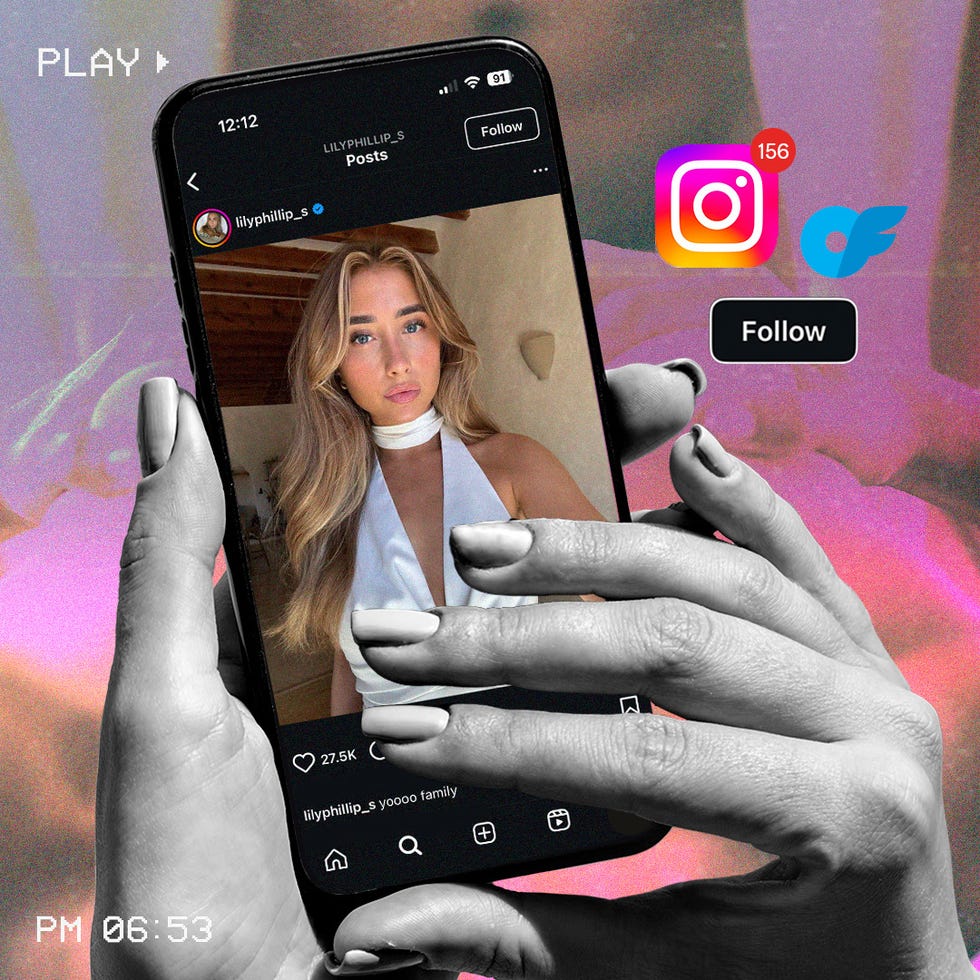I’m sitting in a restaurant off Piccadilly, waiting for Bonnie Blue and her entourage to arrive. The meeting has been months in the making, so I’m relieved when I see her walk in, back in the UK for a week having spent the last six in the US. As she approaches our table, dressed to the nines, a guy sitting nearby does a disbelieving double-take — such is the OnlyFans creator’s notoriety.
While some adult actors, like Stormy Daniels, have become household names, for the most part, we keep our porn viewing habits — and therefore the stars we watch — a secret. Today, though, there’s a new wave of porn stars taking over our group chats and social media timelines. And love them or hate them, we haven’t been able to escape them — not just on the sexy side of the internet, but in the tabloids, on daytime TV, and even most recently on BBC Newsnight. They’re famous, yes, for their extreme sex stunts, but more for the outrage they generate.
For anyone who somehow lives a gloriously media-free existence, it all began last year with 25-year-old Bonnie, who, after launching her OnlyFans account in 2023, achieved virality by visiting university hotspots during Freshers’ Week (or ‘Schoolies Week’ in Australia) and inviting “barely legal” students to have sex with her for free, providing they consented to being filmed for her OnlyFans.
Then, in October, 23-year-old Lily Phillips — another OF creator, who joined the platform in 2020 — made headlines for a different sex stunt: sleeping with 100 men in one day. The men were recruited online, and, like Bonnie’s offer, the sex would be free but filmed for content. Lily also invited filmmaker Josh Pieters to document the day, and his YouTube documentary, I Slept With 100 Men in One Day, skyrocketed her to global infamy (it’s since been viewed over 10 million times).
The pair — who’ve worked together in the past but are now allegedly feuding — have been in a sex war, of sorts, since then, trying to out-do each other with ever more extreme stunts. In January, Bonnie claimed to have broken the world record by sleeping with 1,000 men in a day. In February, the pair courted significant controversy after playing up to separate pregnancy rumours. In March, Lily and adult star Tiffany Wisconsin claimed to have had anal sex with 50 men in one day. And in April, Bonnie announced her intention to sleep with 2,000 men in 24 hours.
At the same time, they’ve become regulars in the tabloids and beyond. But while we all seem to be obsessed with talking about them, with publications churning out op-eds around the perils of this new era of sex extremism and questioning whether we should be ‘shaming’ the masked men, very few appear to be interested in speaking to them. When they do make appearances on podcasts or mainstream TV, nuance tends to get lost, with interviewers instead focusing on what their parents think of their chosen career, or blaming Bonnie and Lily for broader societal ills.
So, I was keen to hear from them. I wanted to learn more about their work, unprecedented overnight fame, and how it feels to be figures of hatred. I also wanted to explore what impact this intense interest (see: outrage) in the sex industry — coupled with the global shift towards conservatism — is having on sex workers, sex-positive content creators, and the rest of us. Because while the rage might be directed at Bonnie and Lily (paying their bills in the process), it’s also feeding into the conservative anti-porn machine. And, if you think shock value stunts are bad, widespread sex negativity is significantly more harmful — and its effects can already be felt beyond the porn community.
A new porn USP
Both Lily and Bonnie’s starts in the industry are well-known by now. Bonnie went from recruitment to OnlyFans after a two-year sabbatical in Australia gave her a taste for life without a nine-to-five. Lily, a university drop-out, took the risqué Instagram to OnlyFans route. The stunts came later.
“I was loving making content, but I realised how overly-edited it was,” Bonnie tells me. “The guy would take Viagra, we’d position the camera so his penis looked bigger, and we’d crop out all the bits where he [paused because he] thought he was going to finish. The videos were so fake, and didn’t [reflect] that people could also have sex and it lasts 10 seconds.”
In January, when I meet Lily over Zoom (she’s also been spending time in the US, and had just attended the AVN Awards, the so-called Oscars of porn), she shares a similar sentiment. “After a while, all my porn was starting to look the same. That’s why I decided to do challenges. I wanted to push the boundaries, and do something that could involve subscribers in my content.”
Despite what sensationalist headlines would have you believe, the average OnlyFans creator earns just $1,300 (£984) a year, while those in the top 1% (the ones the media talks about) earn roughly $18,700 (£14k) per month. Amid such stiff competition, sex workers have to get creative in order to stand out. Many offer personalised experiences, like custom videos and photos, penis ratings, and private DMs.
For their part, both Bonnie and Lily were doing pretty well when they first started, but wanted to do better — not just in income, but in notability. In other words: they wanted to make a splash. “I do get off getting guys off,” says Lily, “but I’m also trying to make a bit of a name for myself.”
Obviously, this isn’t just a porn thing; the attention economy in general rewards bombastic exploits, controversial rage bait, and risky content. As sex work goes, Bonnie and Lily have taken this to the extreme, but are their stunts really so different from YouTubers spending seven days buried alive, attaching fighter jet engines to their trucks, or… setting themselves on fire?
In many ways, no. Much of the controversy, though, stems from the involvement of non-sex workers (“That’s what our selling point is,” says Lily, “there aren’t many girls you can subscribe to [on OnlyFans] but also fuck”), especially those who are 18 and 19 years old.
Everyone involved in these stunts is over 18 (according to ID checks run by Bonnie and Lily’s teams) and very much — enthusiastically — consenting. But when I question whether the young men in these stunts understand the significance of what they’re signing up for, Bonnie says the criticism “is stupid”, adding, “we’ve got no problem sending 18-year-olds to war.”
In both Bonnie and Lily’s videos, participants’ faces don’t tend to be shown, and, as above, the pair each assure me they get full, informed consent from participants before filming. Consent can also be revoked at any time — and, if it is, the cameras will stop rolling. Neither Bonnie nor Lily share profits with the men, but they do get a copy of the footage.
Bonnie also claims that her stunts with (over 18) teenage civilians (aka non-porn actors) are a way of educating participants about sex. When I sceptically quiz her on this, she doubles down. “If I had a child, I’d be sending them to one of these events,” she insists. “I provide a safe, judgement-free environment with security-scanned ID and a breathalyser test. And [participants] are doing something good for society by putting an educational video out there. What part of that is dangerous?”
While I understand what Bonnie’s getting at, I find this reasoning fairly disingenuous — though I don’t blame her for using it. Porn isn’t — and shouldn’t be — educational. It’s a fantasy. It isn’t a porn creator’s job to educate young people about sex, just as it isn’t a stunt driver’s job to teach people how to drive. To me, Bonnie’s work is just that: money-making work. But when society doesn’t acknowledge your work as work, you can be forced to rationalise it in other ways.
A hard day’s work
For Lily, the motivation has always been, she says, pleasure. So, when clips of her in tears in the I Slept With 100 Men in One Day documentary went viral, many people felt she’d been caught in a lie.
“It’s not for the weak girls if I’m honest,” Lily reflects, when filmmaker Josh Pieters asks her how the challenge went. “It was hard. I don’t know if I’d recommend it.”
“Was it more intense than you thought it might [be]?” Pieters replies.
“Definitely,” Lily admits, starting to cry. A few minutes later, she expands on her emotional reaction. “Obviously because there were so many guys, not all the experiences were going to be good… With a few of them, I felt like I had to keep going when their time limit was up” — each guy had an allotted five minutes — “because I hadn’t made them come [yet], and I felt bad because they’d come all this way.” She also says she disassociated at points.
On social media, people were quick to point to this moment (which was in contrast to Lily’s bravado about the stunt earlier in the documentary) as evidence that she is actually a victim — of herself, the patriarchy, and the men who attended the stunt.
Sex workers and allies, including myself, see it differently. As sex worker Jessie Sage pointed out in an article for Rolling Stone at the time, those who work in the sex industry are rarely afforded “space to express ambivalence or complex feelings about their work… We have to constantly perform happiness and fulfilment, lest we be judged harshly for our choices,” she wrote.
This rings true for Lily. “It was a really exhausting experience and a very intense day at work,” she reflects, months after the event. “In a normal job, I’m sure some days you go home after a hard day and feel upset. It doesn’t mean that you hate it or want to quit.”
Still, there’s no denying that the documentary is a hard watch. Lily is frequently self-depreciating, and she and her team come across as naive. The day is poorly organised, lacking safety and security measures. Lily doesn’t seem to know how STIs are transmitted, and is fairly lax about testing. When participants drop out last minute, her team invites people to bring their mates — no vetting or testing done in advance.
Lily acknowledges that lessons were learnt. “That was our first time, so I can’t expect it to have gone 100% right,” she tells me. “There’s things I would have changed, like doing big groups rather than one-to-one, and [being more rigorous with] sexual health testing. But 100 [men] was a kink that I wanted to indulge in. And luckily I was totally fine, and I’m on PrEP.”
The quintessential moral panic
In January, a month after Lily’s documentary landed, Bonnie completed her 1,000 men in a day challenge, pipping Lily — who’d announced her own intention to do it — to the post. “I wanted to give back and say thank you [to my subscribers],” she says of the motivation behind the stunt. “It was fun! Other people have hobbies — they want to hike or do marathons — for me, I wanted to give and receive pleasure for 24 hours.”
Unlike Lily’s one-to-one approach, Bonnie’s challenge was done in groups. There was security outside the building and at the door of the bedroom, IDs were scanned, and consent forms had to be signed. There wasn’t mandatory STI testing.
Videos of hundreds of masked men queuing for their ‘turn’ did the rounds on social media, as did one clip that showed a mother trying to drag her son away from the event. “I’d already taken his virginity,” Bonnie tells me. “The reason his mum was asking for the coat is because he was naked. The deed had been done.”
Although Bonnie and Lily’s stunts are, in some ways, symptomatic of an overly-saturated adult market, consisting of not just porn studios but autonomous creators, challenges like this have existed in the porn industry since the dawn of, well, the porn industry. The most notable example of ‘X’ men in a day stunts is The World’s Biggest Gang Bang porno series. In 1995, porn star Annabel Chong allegedly slept with 251 men in a day for the franchise (there was also a documentary, 1999’s Sex: The Annabel Chong Story); in 1996, Jasmin St Claire reportedly had sex with 300 men; and in 1999, Houston supposedly slept with 620 men. Before Bonnie, it was Lisa Sparxxx who held the world record, having allegedly slept with 919 men in one day at the annual World Gangbang Championship in Warsaw in 2004.
Take all of this with a pinch of salt, though. Over the years, it’s emerged that these numbers were likely inflated. In reality, there were apparently only 70 men at Chong’s event, 30 at St Claire’s, 180 at Houston’s, and 150 at Sparxxx’s. “We only realised [they] were fake afterwards,” Bonnie says when I share these revelations. “It’s annoying. But even if I’d have gone into it knowing the record was less, it wouldn’t have changed the fact that I wanted to do 1,000.”
“Is yours real?” I ask, knowing she wouldn’t tell me even if it wasn’t. “The whole thing was documented,” she asserts. “I can show you the evidence.”
So, this has all been done before — and yet it’s being framed as more shocking than ever. The World’s Biggest Gang Bang films weren’t without their own controversies, but they remained relatively niche: they were pornos, only available via mail-order or in a curtained-off section of a video store. Bonnie and Lily, meanwhile, are everywhere; we’re faced with them on our feeds, whether we want to see them or not (the porn itself is behind a paywall).
This is because they make perfect tabloid fodder at a time when sex negative conservatism is on the rise. They’re the quintessential moral panic: beautiful, blonde, middle class girls leaving their ‘respectable’ lives to proudly enter the sex industry, debasing ‘innocent’ men in the process. The message is clear: your daughter could be the next!
Bonnie and Lily are the antithesis to the down-and-out sex worker archetype. “People look at me and go, ‘Why are you a sex worker? You could do so many other things’,” says Bonnie. “They expect me to be damaged. That’s what irritates people so much. It goes against everything they’ve ever tried to say about women who do sex work. There’s no [traumatic] background; no one’s forcing me to do it; I’m not in a difficult position financially — it’s as simple as I enjoy sex.”
Anti-porn feminists have long argued that all sex work is a form of exploitation by men, and that sex workers are harming themselves and other women with their line of work. This view — which is still widespread, even among young people — means that sex workers, especially those who sell sex, are perceived as victims, as opposed to autonomous workers. As a result, they’re criminalised, stripped of workers’ rights, subjected to stigmatisation and violence, all while being ignored when it comes to legislation that affects their lives.
The irony, of course, is that this brand of feminism doesn’t actually seek to help sex workers — rather, it’s hoping to eradicate them. And so, while Lily, portrayed as a fallen girl next door, fits into their victim mold, someone like Bonnie requires a second caricature in order to villainise the sex worker: she is a man-eater, luring porn-brained young men into immorality.
Bonnie has, admittedly, played up to this, and some of her comments have been rightly criticised. She’s suggested that women are to blame for their partners’ infidelity, saying that if they were “better in the bedroom”, “nagged” less, or weren’t “boring”, men wouldn’t cheat.
“I do understand that,” Bonnie says when I suggest that these comments are sexist and reinforce harmful stereotypes. “It wasn’t, ‘You have to pleasure your husband’, but more, ‘If you’re not pleasuring him, he’ll go to a sex worker’.”
To me, those statements infer the same thing: give your partner sex, or expect him to go elsewhere. And, while I believe this is mostly rage bait, these are the kinds of comments peddled by the manosphere that encourage young men to believe they’re owed sex from women. In the end, Bonnie and I go around in circles debating the topic. I can’t tell whether she really believes what she’s saying, or if it’s a caricature perspective that she feels she has to uphold.
No matter what she really believes, though, Bonnie says she wouldn’t win either way. “If I label myself as a feminist, they’ll start going, ‘This isn’t feminist, that isn’t feminist’, and they can’t accept the fact that I don’t believe in every single part [of feminist thinking],” she tells me, ever aware of how the public will respond to her. “But yes, I want equal rights.”
What are we really mad about?
There are a number of valid criticisms levelled against Bonnie and Lily, including, as mentioned, the involvement of young non-sex workers in their stunts, claims that their work is purely for pleasure or educational purposes (as opposed to money and virality also being relevant), and a seeming lack of safety measures — like STI testing — at their events.
It’s not all gratuitous moralising, either. No matter your stance on the stunts, there’s no denying that hordes of masked men lining up to have sex with one woman is a jarring image, and it’s worth questioning how this might impact young men’s perception of women — and sex — in general.
This is particularly pertinent at a time when anti-feminist sentiment is growing, buoyed by manosphere influencers who promote archaic, misogynistic views. A recent study found that, among Gen Z, 57% of men and 36% of women think gender equality has gone too far and is now discriminating against men, while just 53% of Gen Z women and 32% of men say they consider themselves to be feminists. This is having a knock-on effect in behaviours. Violence against women and girls is on the rise; one in seven young women have experienced threats to share their intimate images or videos; and 57% of under-18s are concerned about falling victim to deepfake pornography.
Bonnie and Lily aren’t responsible for this — and shouldn’t be held accountable for all the societal failures that have led to this point. In interviews, they’re asked to reckon with how their work might be fuelling misogyny. It’s a question familiar to sex workers, who, as Ruby, an online porn worker and member of the Sex Workers Union, puts it, are often accused of being “both the cause and voiceless victims of misogyny”. But, she continues: “Misogyny would exist with or without sex work because the patriarchy is a vital tenet of capitalism. I don’t think Lily and Bonnie are doing anything necessarily to dismantle the patriarchy, but they’re certainly not fuelling it.”
So, where should our outrage really be directed?
A lot of people lay the blame at pornography’s door, suggesting violent porn is responsible for a rise in sexism, rape culture, and violence, despite there being little evidence of a correlation between the two. That being said, there is evidence that young people are copying what they see in porn, including choking (which has, disturbingly, become a mainstay in real-life encounters). In this sense, what’s more concerning is a lack of porn literacy — as per a 2016 study, most boys think online pornography is realistic — which stems from insufficient sex education and a resistance from lawmakers, schools, and parents to broach the topic with young people.
So, perhaps some of this outrage towards sex workers like Bonnie and Lily would be better directed at the rise of deepfaked adult content, intimate image abuse, and other non-consensual sexual content that is allowed to flourish on the internet.
As Lily concludes: “I’m not an influencer or a public figure. I’m a porn star. I’m making porn.”

Brit Dawson is Cosmopolitan UK’s Sex & Relationships Editor. Her work mostly delves into sexual subcultures, sex work, women’s rights, and sex and relationships, exploring how each intersects with technology, politics, and culture. Formerly a staff writer at Dazed and MEL Magazine, she’s written for British GQ, The Face, Slate, and more. She’s also interested in drugs, youth and pop culture, and books — so all the good stuff. Find Brit on Instagram, X, and LinkedIn.
This post was originally published on this site be sure to check out more of their content.








